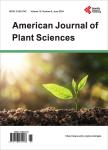Physiological Performances of Temperate Vegetables with Response to Chronic and Acute Heat Stress
Physiological Performances of Temperate Vegetables with Response to Chronic and Acute Heat Stress作者机构:Natural Sciences and Science Education Academic Group National Institute of Education Nanyang Technological University Singapore
出 版 物:《American Journal of Plant Sciences》 (美国植物学期刊(英文))
年 卷 期:2016年第7卷第14期
页 面:2055-2071页
学科分类:08[工学] 080502[工学-材料学] 0805[工学-材料科学与工程(可授工学、理学学位)]
主 题:Chlorophyll Fluorescence Heat Stress O2 Evolution Photosynthetic CO2 Assimilation Rate Stomatal Conductance Thermotolerance
摘 要:In face of climate change catastrophes, understanding the thermal limits and optimal physiological thermal window food crop is of particular urgency. This research aims to evaluate: 1) how physiological performances of plant will change with increasing chronic and acute heat stress;2) if the examined parameters form a hierarchy in terms of thermal tolerance;and 3) the optimal thermal window and critical temperatures of the examined plants with response to chronic and acute heat stress. Six temperate vegetables were subjected to chronic and acute heat stress and a suite of physiological parameters were evaluated. Dose responses were observed in shoot fresh weight, photosynthetic gas exchange, photosynthetic oxygen evolution, electron transfer rate, photo- and non-photochemical quenching with significant drop in performance as early as 28°C for selected species. Conversely, ratio of variable to maximum fluorescence (Fv/Fm) was not affected by heat stress until 46°C in chronic heat stress. Examining the temperature at which a measured parameter’s performance dropped by 50% compared to control (LT50), a distinct hierarchy of the indices was observed for Canasta, recombinant inbred line 141, Lactuca serriola and Lactuca sativa (L. “Salinas): shoot fresh weight, representing the highest integrated level of photosynthesis was the most sensitive to thermal stress (28°C - 30°C), followed by oxygen evolution (35°C - 45°C) while non-photochemical and photochemical quenching which is subcellular function of stress alleviation had a much higher capacity failure temperature (47°C - 60°C). It is expected that Fv/Fm ratio, a measurement of sub-cellular structural integrity, will approach that of non-photochemical and photochemical quenching, if not exceeding it. By examining the photosynthetic parameters via their hierarchy of biological organization, it can be inferred that plants like Arugula



